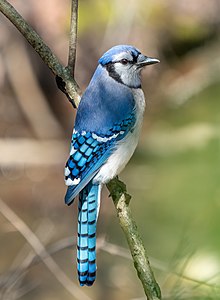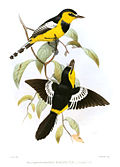| Cyanocitta | |
|---|---|

| |
| C. cristata | |
| Scientific classification | |
| Domain: | Eukaryota |
| Kingdom: | Animalia |
| Phylum: | Chordata |
| Class: | Aves |
| Order: | Passeriformes |
| Family: | Corvidae |
| Subfamily: | Cyanocoracinae |
| Genus: | Cyanocitta Strickland, 1845 |
| Type species | |
| Corvus cristatus Linnaeus, 1758 | |
| Species | |

| |
| Distribution of the Cyanocitta jays in North America. Red: Steller's Jay (Cyanocitta stelleri), black: Blue Jay (Cyanocitta cristata). Dotted line: irregular wintering, dashed line: irregular breeding. | |
Cyanocitta is a genus of birds in the family Corvidae, a family which contains the crows, jays and magpies. The genus includes two crested jays with blue plumage and a distinctive feather crest. Found only in temperate North America, the Rocky Mountains divide the two species. These jays inhabit deciduous, mixed, and coniferous forests, feeding mainly on seeds, invertebrates, and small vertebrates, with occasional human food. As omnivores, they breed from spring to early summer, nesting in treetops or bushes with clutches of three to six eggs. They are the only American corvids that use mud in nest-building. Despite their similarities, the two species differ in migratory behavior, socialization, and mating habits.
Description
Crested jays are relatively slender corvids with similar body shapes but differ in size. Steller’s jay is larger than the blue jay. Their strong black beaks have a small hooked tip and minimal bristles. They have slightly rounded, medium-to-long tails and relatively short wings. A feathered crest is more pronounced in Steller's jay. Both species are blue, black, and white with distinct black-banded tails and wings—a unique trait among American corvids. Males are slightly larger, but both sexes have similar coloring.
Flight
Steller’s jay has powerful, steady wing beats, while the blue jay’s long-distance flight includes flatter beats, alternating with gliding over short distances. Both species prefer hopping over walking on the ground and are agile in trees.
Vocalization
Crested jays have diverse vocal repertoires, from croaks and energetic calls to melodic sounds. Both species are skilled imitators, mimicking buzzard calls, other birds, mammals, and even mechanical noises. The purpose of this mimicry in the wild is still debated.
Systematics
Established by Hugh Edwin Strickland in 1845, it contains the following species and subspecies:
| Common name | Scientific name and subspecies | Range | Size and ecology | IUCN status and estimated population |
|---|---|---|---|---|
| Blue jay | Cyanocitta cristata (Linnaeus, 1758) Four subspecies
|
Eastern Canada, eastern and central United States
|
Size: 25–34 cm, 70–100 g Habitat: coniferous forest and scrub habitat Diet: seeds and nuts, such as acorns, soft fruits, arthropods, and small vertebrates. |
LC
|
| Steller's jay | Cyanocitta stelleri (Gmelin, JF, 1788) Thirteen subspecies
|
west of the Rocky Mountains
|
Size: 30–34 cm, 100–142 g Habitat: coniferous forests Diet: seeds, nuts, berries and other fruit, invertebrates, small rodents, eggs |
LC
|
The name Cyanocitta is a combination of the Greek words kuanos, meaning "dark blue", and kitta, meaning "jay".
Distribution
Crested jays inhabit temperate North America, divided by the North American Cordillera. This distribution likely resulted from glaciation during the last ice age. The blue jay occupies the flat eastern regions up to the Rocky Mountains, while the Steller's jay is found in the western mountains and adjacent temperate areas. Both species overlap only in southwestern Canada, reaching the warm temperate zone's northern edge in Canada and Alaska. They are absent in arid deserts, valleys, and coastal regions, with distribution becoming more fragmented to the south. Only the Steller's jay extends into tropical regions, inhabiting cooler mountains as far south as Nicaragua. During the Pleistocene, it likely persisted in ice-free southern and western areas, spreading into the Rockies post-glaciation.
The two species differ in migratory habits: the Steller's jay is primarily resident, moving only from high altitudes in winter, while the blue jay migrates seasonally, especially from northern regions. In southern areas, like Florida, blue jays are resident. Steller's jays may migrate more widely after breeding seasons if food is scarce, with many juveniles moving to peripheral areas.
Habitat
Crested jays prefer open forests, forest edges, parklands, and urban green spaces, showing a strong preference for oak trees when available. Both species thrive in coniferous and mixed forests, with blue jays also frequenting pure deciduous forests. Blue jays adapt well to urban areas, often reaching higher densities than in forests, while Steller's jays are less common in human-populated areas, preferring altitudes between 1,000 and 3,500 meters. Blue jays, in contrast, range widely, from coastal beaches to the Appalachian Mountains.
References
- ^ Walker, Lauren E.; Pyle, Peter; Patten, Michael A.; Greene, Erick; Davison, William; Muehter, Vincent R. (2016-07-01). "Steller's Jay (Cyanocitta stelleri)". The Birds of North America Online. Cornell Laboratory of Ornithology. doi:10.2173/bna.343.
- ^ Smith, Kimberly G.; Tarvin, Keith A.; Woolfenden, Glen E. (2013-12-04). "Blue Jay (Cyanocitta cristata)". The Birds of North America Online. Cornell Laboratory of Ornithology. doi:10.2173/bna.469.
- "ITIS Report: Cyanocitta". Integrated Taxonomic Information System. Retrieved 9 July 2015.
- Smith, Kimberley G.; Tarvin, Kevin A.; Woolfenden, Glen E. (2013-12-04). Poole, A. F. (ed.). "Blue Jay (Cyanocitta cristata)". The Birds of North America Online. Ithaca, New York: Cornell Lab of Ornithology. doi:10.2173/bna.469. Retrieved 2019-08-14.
- Jobling, James A. (2010). The Helm Dictionary of Scientific Names. London, UK: Christopher Helm. p. 126. ISBN 978-1-4081-2501-4.
- BURG, THERESA M.; GASTON, ANTHONY J.; WINKER, KEVIN; FRIESEN, VICKI L. (2005-09-07). "Rapid divergence and postglacial colonization in western North American Steller's jays (Cyanocitta stelleri)". Molecular Ecology. 14 (12). Wiley: 3745–3755. Bibcode:2005MolEc..14.3745B. doi:10.1111/j.1365-294x.2005.02710.x. ISSN 0962-1083. PMID 16202093.
- Goodwin, Derek; Gillmor, Robert (1986). Crows of the world. London: Natural History Museum Publications. ISBN 0-565-00979-6.
- Hoyo, Josep del; Elliott, Andrew (1992). Handbook of the Birds of the World: Bush-shrikes to Old World sparrows (in German). Barcelona: Lynx ed. ISBN 978-84-96553-50-7.
External links
 Media related to Cyanocitta at Wikimedia Commons
Media related to Cyanocitta at Wikimedia Commons Data related to Cyanocitta at Wikispecies
Data related to Cyanocitta at Wikispecies
| Genera of corvides and their extinct allies | |||||||||||||||||||||||||||||||||||||
|---|---|---|---|---|---|---|---|---|---|---|---|---|---|---|---|---|---|---|---|---|---|---|---|---|---|---|---|---|---|---|---|---|---|---|---|---|---|
| |||||||||||||||||||||||||||||||||||||
| |||||||||||||||||||||||||||||||||||||
| |||||||||||||||||||||||||||||||||||||
| |||||||||||||||||||||||||||||||||||||
| Taxon identifiers | |
|---|---|
| Cyanocitta | |
This Corvidae-related article is a stub. You can help Misplaced Pages by expanding it. |









